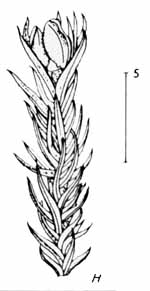
Branchlet with ripe fruit (2).
Common Names
Celebes: sareh (Ulu Sahu, in Upper Binuang); New Guinea: djariha (Asaro, Kefanio), gu-gra-goin (Goroka, Hagen), jumbiri (Mendi on Mt. Giluwe), kaiwilpitti (Waghi, Minj), kubil-kaibigi, kubu-kaibek, (Minj, in Kubor Range), kubin (Hagen, Togoba), ma-u (Naho in Finisterre Range), nubiri (Mendi), pau (Hagen-Wabag, Enga), piepienie (Tan, Huli on Mt. Ne), u(m)ba (Chimbu, Goromagua, Masul) (2, 3).Taxonomic notes
Syn: Podocarpus cinctus Pilger 1938; Podocarpus dacrydiifolia Wasscher 1941; Dacrycarpus dacrydiifolia (Wasscher) Gaussen 1974 (3).Description
"Often flat-crowned tree up to 33 m, 20-90 cm diam., or a shrub 2-4 m tall. Leaves of primary shoots spreading slightly, straight or more often curved forward, 5-6 mm long on young plants, becoming 3-4 mm long on adult plants and 2-3 mm long at the base of foliage shoots and fertile structures. Leaves of juvenile foliage shoots not distichous or perhaps slightly so, linear-lanceolate, the upper half curved forward, 0.5-0.8 mm wide. Leaves on older trees eventually becoming similar to the leaves of primary shoots but somewhat narrower and curved like the juvenile leaves, 2-5 by 0.4-0.6 mm, uniform along a shoot, often glaucous. Pollen cone sometimes on long shoots. Involucral leaves resembling the foliage leaves but curved throughout their length, completely surrounding the developing seed with its covering which rises slightly above them when mature, 6-10 mm long. Receptacle bright red when ripe. Seed with its covering 7 mm long and 6-7 mm diam." (3).Similar Species: "Collectors complain that this species grades into D. compactus and indeed in the zone of overlap between these two species specimens of D. cinctus have shorter and more robust leaves resembling D. compactus, while the common glaucousness of D. cinctus has been observed to disappear above 2950 m. The two species are substantially different, however, and both become much less common in the elevations where they overlap (2900-3400 m). Perhaps hybridization occurs where they overlap" (3).
Van Royen, writing particularly of the New Guinea populations, describes it thusly: "Trees up to 30 m, rarely a shrub up to 4 m. Bark brown to black, cracking into small scales and plates. Leaves when young slightly bilaterally flattened and distichous, 9-12 by 0.5-0.8 mm, falcate, curved upwards and acute at tip, mature leaves all equal, lanceolate, slightly bifacially flattened, 2-3(-5) by 0.5 mm, falcate, acute or needle-tipped, spreading, glabrous. Male inflorescence a 4-10 by 2-3 mm, globose or ellipsoid catkin, stalk 2-3 mm long, microsporophylls acuminate, 1.5-2 mm long, anther-sacs globose-ellipsoid, 0.5 mm long. Female cone on a lateral brachyblast or terminal, 5-15 mm long, involucral leaves 6-7 mm long, longer than normal leaves, needle-tipped, clasping the young seed, crested, glabrous. Receptacle narrowly conoid, 3-4 mm long, warty. Sterile bracts 1 or 2, surpassing the ovule. Seeds and receptacle red when mature, involucral leaves clasping lower part only, seed ellipsoid to subglobose, 6-7 by 7-7 mm, with a small asymmetrical crest" (2).
Range
Central Celebes, Moluccas (Central Ceram: G. Binaja), and throughout New Guinea. "In New Guinea extremely common and often dominant, or co-dominant with Nothofagus, Libocedrus, Elaeocarpus and Podocarpus, in mountain forest and mossy forest, on Mt. Binaja in orchard-like pure stands with a mossy ground cover, rarely in muddy parts of swamps (Iowasi swamp near Woitape), a canopy tree or sometimes emergent, often thick-trunked, the foliage glaucous or not, 1800-2850 m, occasionally as high as 3600 m, in Ceram from 1300-3000 m, in Celebes reported as low as 900 m" (3)."Distributed in New Guinea as follows:
"TNG. Tamanagabid track to Busilmin, Sirius Plateau, Andabare - McNicoll plateau, Wapu River, Wabag Valley, Mt Hagen area, Kubor Range, Keglsugl -Mt Wilhelm area, Kerigomna Camp, Marafunga, Omahaiga Valley, Finisterre Mts, Sarawaket Mts, Cromwell Mts, Rawlinson Mts, Aseki area.
"PAPUA. Mt Ne - Mt Kerewa area, Kaguba, Mt Jalibu, Mt Giluwe, Mt Simpson, Wharton Range, Mt. Albert Edward, Mt Victoria, Mt Suckling.
"A species from the montane belt to the subalpine shrubberies, 1920-3600 m. Flowers April - January" (2).
Big Tree
Oldest
Dendrochronology
Ethnobotany
Observations
Remarks
Citations
(1) Silba 1986.(2) Van Royen 1979.
(3) de Laubenfels 1988.
[Dacrycarpus] [Podocarpaceae] [home]
This page is from the Gymnosperm Database
URL: http://www.geocities.com/RainForest/Canopy/2285/po/da_s/cinctus.htm
Edited by Christopher J. Earle
E-mail:earlecj@earthlink.net
Last modified on 21-Dec-98